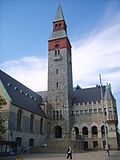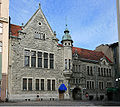This article needs additional citations for verification .(January 2020) |

The National Romantic style was a Nordic architectural style that was part of the National Romantic movement during the late 19th and early 20th centuries. It is often considered to be a form of Art Nouveau.
Contents
The National Romantic style spread across Denmark, Norway, Sweden, Finland, Estonia, and Latvia, as well as Russia, where it also appeared as Russian Revival architecture. Unlike some nostalgic Gothic Revival style architecture in some countries, Romantic architecture often expressed progressive social and political ideals, through reformed domestic architecture. [1]
Nordic designers turned to early medieval architecture and even prehistoric precedents to construct a style appropriate to the perceived character of people. The style can be seen as a reaction to industrialism and an expression of the same "Dream of the North" Romantic nationalism that gave impetus to renewed interest in the study of the history of Scandinavia, along with the rediscovery of the eddas and sagas of Nordic mythology.









































